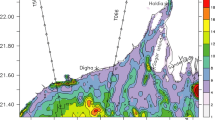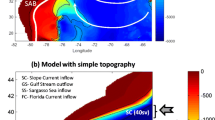Abstract
A terrain-following ocean model is implemented for simulating three-dimensional tidal and residual circulations in the Gulf of Khambhat and its adjacent oceans on the west coast of India. The model is forced with time varying tidal levels and momentum fluxes at the western and southern boundaries. Simulated tidal levels and currents compare well with the observation at tide gauge and current-meter stations. Estimated residual circulation in the region has several notable features that include strong southward along channel flow inside the gulf, northwestward propagating coastal boundary jet currents parallel the 60 m isobaths, southward slope currents, alongshore coastal currents on the southeastern flank of the shelf and a number of meso-scale eddies. All these features of residual circulation are captured well by the satellite imagery of Chlorophyll concentration mapped in the month of March, the period when tide plays dominant role on the control of net circulation in the region.







Similar content being viewed by others
References
Admiralty tide tables: Vol. 2. (1996). UK: Hydrographer of the Navy.
Barltrop, N. D. P. (Editor) (1998). Floating structures: A guide for design and analysis, Volume One, OPL.
Blumberg, A. F., & Mellor, G. L. (1987). A description of a three-dimensional coastal ocean circulation model. In N. S. Heaps (Ed.), Three-dimensional coastal ocean models (pp. 1–16). Washington, DC: American Geophysical Union.
Carton, J. A., & Giese, B. S. (2008). A reanalysis of ocean climate using Simple Ocean Data Assimilation (SODA). Monthly Weather Review, 136, 2999–3017.
Denniss, T., & Middleton, J. H. (1994). Effects of viscosity and bottom friction on recirculating flows. Journal of Geophysical Research, 99(C5), 10,183–10,192. doi:10.1029/93JC03588.
Foreman, M. G. G. (1978). Manual for tidal currents analysis and prediction. Pacific Marine Science Report 78–6, Institute of Ocean Sciences, Particia Bay, Victoria, B.C. x. pp.
Garreau, P., & Mazé, R. (1992). Tidal rectification and mass transport over a shelf break: a barotropic frictionless model. Journal of Physical Oceanography, 22, 719–731.
Geyer, R. W., & Signell, R. (1990). Measurements of tidal flow around a headland with a shipboard acoustic Doppler current profiler. Journal of Geophysical Research, 95, 3189–3197.
Hibiya, T. (2004). Internal wave generation by tidal flow over a continental shelf slope. Journal of Oceanography, 60, 637–643.
Holloway, P. E. (1996). A numerical model of internal tides with application to the AUSTralian northwest shelf. Journal of Physical Oceanography, 26, 21–37.
Huthnance, J. M. (1986). The Rockall slope current and shelf-edge processes. Proceedings of the Royal Society of Edinburgh, B88, 83–101.
International Hydrographic Bureau. (1930). Tides, harmonic constants. Special publication no 26 and addenda. International Hydrographic Bureau.
Kumar, V. S., & Kumar, K. A. (2010). Waves and currents in tide dominated location off Dahej, Gulf of Khambhat, India, Mar. Geod.,vol. 33(2); 218--231.
Lefèvre, F., Lyard, F., Le Provost, C., & Schrama, E. J. O. (2002). FES99: a tide finite element solution assimilating tide gauge and altimetric information. Journal of Atmospheric and Oceanic Technology, 19(9), 1345–1356.
Levitus, S. (1982). Climatological atlas of the world ocean. Washington D.C: U.S. Government Printing Office. NOAA Professional Paper 13, 173pp.
Li, S., & McClimans, T. A. (2000). On the stability of barotropic prograde and retrograde jets along a bottom slope. Journal of Geophysical Research, 105(C4), 8847–8855.
Lyard, F., Lefèvre, F., Letellier, T., & Francis, O. (2006). Modelling the global ocean tides: a modern insight from FES2004. Ocean Dynamics, 56, 394–415.
Mazé, R., Langlois, G., & Grosjean, F. (1998). Tidal eulerian residual currents over a slope: analytical and numerical frictionless models. Journal of Physical Oceanography, 28, 1321–1332.
Mellor, G. L., & Yamada, T. (1982). Development of a turbulence closure model for geophysical fluid problems. Reviews of Geophysics, 20, 851–875.
Nayak, R. K., & Shetye, S. R. (2003). Tides in the Gulf of Khambhat, west coast of India. Estuarine, Coastal and Shelf Science, 57, 249–254.
Rattray, M., Jr., Dworski, J. G., & Kovala, P. E. (1969). Generation of longinternal waves at a continental slope. Deep-Sea Research, 16(Suppl), 179–195.
Robertson, R. (2001). Internal tides and baroclinicity in the southern Weddell Sea: Part I: model description, and comparison of model results to observations. Journal of Geophysical Research, 106, 27001–27016.
Robinson, I. S. (1981). Tidal vorticity and residual circulation. Deep Sea Research, 28A, 195–212.
Thorpe, S. A. (1992). The generation of internal waves by flow over the rough topography of a continental slope. Proceedings of the Royal Society of London A, 439, 115–130.
Unnikrishnan, A. S., Shetye, S. R., & Michael, G. S. (1999). Tidal propagation in the Gulf of Khambhat, Bombay High, and surrounding areas. Proceedings of the Indian Academy of Science (Earth and Planetary Sciences), 108, 155–177.
Acknowledgments
This research work is carried out under a technology development project of National Remote Sensing Centre (NRSC), Hyderabad and Saral ALTIka Science application programme of ISRO-CNES. We thank to our Director for approving the project and providing the necessary support to carry out the work.
Author information
Authors and Affiliations
Corresponding author
About this article
Cite this article
Nayak, R.K., Salim, M., Mitra, D. et al. Tidal and Residual Circulation in the Gulf of Khambhat and its Surrounding on the West Coast of India. J Indian Soc Remote Sens 43, 151–162 (2015). https://doi.org/10.1007/s12524-014-0387-3
Received:
Accepted:
Published:
Issue Date:
DOI: https://doi.org/10.1007/s12524-014-0387-3




